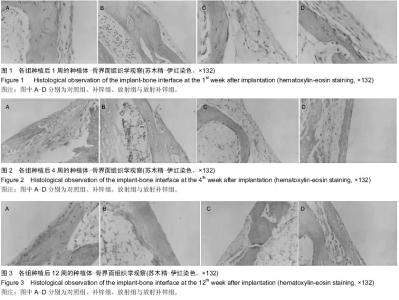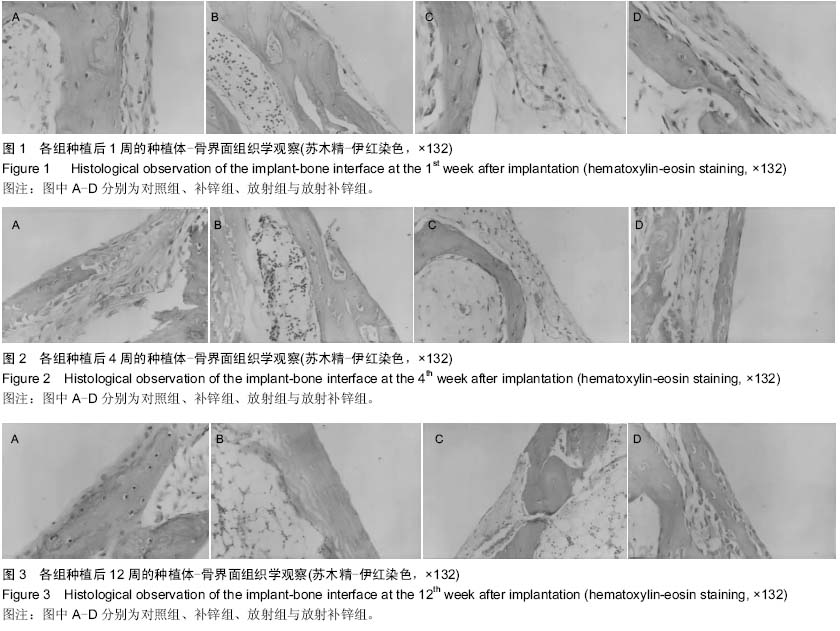| [1] |
Zhang Chao, Lü Xin.
Heterotopic ossification after acetabular fracture fixation: risk factors, prevention and treatment progress
[J]. Chinese Journal of Tissue Engineering Research, 2021, 25(9): 1434-1439.
|
| [2] |
Zuo Zhenkui, Han Jiarui, Ji Shuling, He Lulu.
Pretreatment with ginkgo biloba extract 50 alleviates radiation-induced acute intestinal injury in mice
[J]. Chinese Journal of Tissue Engineering Research, 2021, 25(23): 3666-3671.
|
| [3] |
Huo Hua, Cheng Yuting, Zhou Qian, Qi Yuhan, Wu Chao, Shi Qianhui, Yang Tongjing, Liao Jian, Hong Wei.
Effects of drug coating on implant surface on the osseointegration
[J]. Chinese Journal of Tissue Engineering Research, 2021, 25(22): 3558-3564.
|
| [4] |
Zhang Yanan, Yan Xia, Meng Zengdong.
Zn and Mg increase the bioactivity and osteogenic induction
of hydroxyapatite biomaterial in bone repair: clinical application and
mechanism
[J]. Chinese Journal of Tissue Engineering Research, 2020, 24(4): 606-611.
|
| [5] |
Zhang Xuan, Li Yunpeng, Zhang Xuejian, Yin Chuanrong, Deng Yue.
Guided bone regeneration using preformed titanium mesh combined with bioabsorbable membranes in aesthetic area
[J]. Chinese Journal of Tissue Engineering Research, 2020, 24(26): 4112-4117.
|
| [6] |
Zhao Qiao, Yang Fei, Zhang Chengdong, Chen Shuo, Sun Xiao, Zhang Bo, Xiao Dongqin, Liu Kang, Feng Gang, Duan Ke.
Zinc ion concentration affects proliferation and osteogenic
differentiation of rabbit bone marrow mesenchymal stem cells
[J]. Chinese Journal of Tissue Engineering Research, 2020, 24(19): 2985-2990.
|
| [7] |
Liu Dan, Min Changqin, Lu Shuai, Chen Yue, Sun Yong.
Osseointegration induced by beta-tricalcium phosphate loaded with advanced platelet-rich fibrin
[J]. Chinese Journal of Tissue Engineering Research, 2019, 23(6): 888-893.
|
| [8] |
Li Fang, Cheng Yuting, Huang Xiaolin, Zhou Qian, Wu Chao, Shi Qianhui, Wang Yong, Liao Jian.
Maxillary sinus floor augmentation: with or without bone grafting
[J]. Chinese Journal of Tissue Engineering Research, 2019, 23(6): 971-977.
|
| [9] |
Cui Jiaming, Yang Dazhi.
Treatment strategies for spinal metastases: advantages of 3D printing and precise treatment
[J]. Chinese Journal of Tissue Engineering Research, 2019, 23(36): 5875-5881.
|
| [10] |
Zou Yingnan, Wang Yibo, Ding Chao, Pan Xinyu, Shi Jiuhui .
Three-dimensional finite element analysis of dental implant combined with residual tooth after hemisection under dynamic loads
[J]. Chinese Journal of Tissue Engineering Research, 2019, 23(2): 178-183.
|
| [11] |
Xie Zhong, Yang Mingzhi, Xue Jingbo, Chen Yong, Peng Lijun, Cai Bin, Zhang Yangyang.
Antibacterial properties of biodegradable zinc alloys in vivo
[J]. Chinese Journal of Tissue Engineering Research, 2019, 23(14): 2196-2201.
|
| [12] |
Wang Liping, Chen Weihong, Zha Jun, Chen Xili, Su Yucheng, Fang Ying, Dong Yu, Guo Xueqi, Ge Linhu.
Short-term efficacy evaluation of Mis Seven implant system repairing dentition loss
[J]. Chinese Journal of Tissue Engineering Research, 2019, 23(14): 2208-2214.
|
| [13] |
Li Ying, You Yapeng, Li Baoe, Song Yunjia, Ma Aobo, Chen Bo, Han Wen, Li Changyi.
Type I collagen combined titanium dioxide nanotube composite coating modified titanium surface improves osteoblast adhesion and osseointegration
[J]. Chinese Journal of Tissue Engineering Research, 2019, 23(14): 2169-2176.
|
| [14] |
Wei Wei, Shu Jing-ai, Wang Jing, Zheng Li-xia, Li Lu, Wang Qing-shan.
Application of hydroxyapatite functional graded biomaterials in human hard tissue replacement
[J]. Chinese Journal of Tissue Engineering Research, 2018, 22(6): 971-978.
|
| [15] |
Liu Ou, Gao Zhu, Li Tao, Zhou Bo.
Minocycline hydrochloride ointment is available for the treatment of peri-implantitis
[J]. Chinese Journal of Tissue Engineering Research, 2018, 22(6): 852-857.
|

